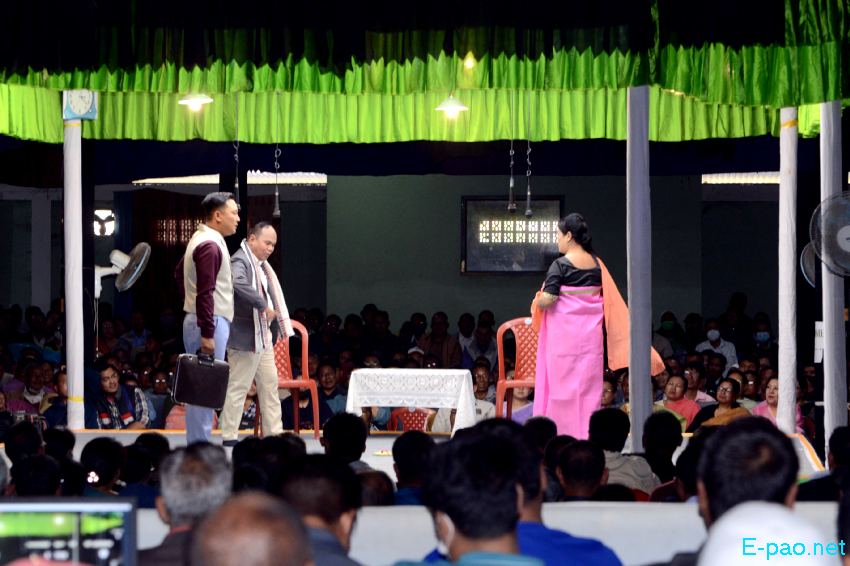Advocating a paradigm shift in the artistic portrayal of drug use
Haobam Nanao *

51st All Manipur Shumang Leela Festival at Iboyaima Shumang Leela Shanglen in February 2023 :: Pix - Khaba Kh
My beautiful State of Manipur is renowned for excelling in the fields of arts, culture, and sports, earning the title of India’s powerhouse of sports. This has been consistently proven on both National and global platforms.
The people of this land have brought laurels to the Nation, with many individuals achieving global recognition and accolades. These threefold excellences have brought immense pride and fame to the people of our motherland.
Recently, while scrolling through Facebook reels, I came across a snippet of a Shumang Kumhei (Courtyard play) featuring Shougrakpam Hemanta, popularly known as Oja Tolhan, and a co-actor. They engaged in a satirical dialogue where he ridiculed his ex-lover over the death of her husband, who was “a No.4 addict.”
The audience enjoyed a good laugh, highlighting the thrill of a good performance. This is just one example of how drug use is incorporated into Shumang Lila, whether in serious scenes, morbid humor, or dark parody.
Similarly, Manipuri cinema often portrays drug use in a negative light, sending an unfavorable message to the audience. Although I am not a critic, merely an observer, I have noticed this recurring theme quite often.
I am an ardent fan of Shumang Kumhei, also known as Shumang Leela (Courtyard Play), a traditional Meitei form of theatre usually performed in Manipur. Although I am selective about the parties or groups I follow, I keep track of this art form through social media, particularly on YouTube.
Shumang Kumhei and cinema serve as unwavering entertainment, reflecting society and propagating ideas, raising awareness, and educating the masses on relevant matters. This impact is as significant today as it was in earlier times.
Manipur has been reeling under a multifaceted issues of drug use, ranging from alcohol and pharmaceuticals to opioids, amphetamines, and other synthetic drugs, for about four decades now. This crisis affects all ages and genders, with a notable rise among the youth.
Over the years, society’s outlook on drug use has shifted from a criminal and moralistic view to recognizing it as a health issue needing treatment and attention.
This change is due to the concerted efforts of the drug user community, civil society organizations, commu- nity-based organizations, and concerned Governmental departments. However, the myriad issues persist, and addressing them requires a humane and con- textually appropriate response.
Shumang Kumhei has been portraying various issues of drug use, raising public awareness about the negative consequences and associated stigma and discrimination for a long time. Injecting drug and its related blood-borne infections like HIV have also been depicted in different plays.
The same themes have been adopted in commercial cinemas in Manipur. Without delving into the technicalities of these traditional art forms, I would like to express a major concern, which is more of a suggestion than an opinion.
These popular art forms have dramatically spread awareness about the adverse effects of drug use in society over the years. As a person who has used drugs and is involved in promoting human rights, advocating prevention and treatment of addiction from a public health perspective, I seek a paradigm shift in how these art forms portray drug use-related scenes or stories.
We all know that drug use is not a healthy contribution to society, but it has not been eradicated. Scientifically, it is now recognized as an illness needing treatment like any other illness.
Based on this fact, story writers, script-writers, dialogue writers, directors, and others involved should go beyond the traditional portrayal of drug use and focus on preventive and treatment measures in the best possible manner. I firmly believe that such a change will have a positive societal impact on the issue of drug use and will further enrich these artistic forms.
* Haobam Nanao wrote this article for The Sangai Express
The writer is a Drug User’s Activist
This article was webcasted on July 26 2024.
* Comments posted by users in this discussion thread and other parts of this site are opinions of the individuals posting them (whose user ID is displayed alongside) and not the views of e-pao.net. We strongly recommend that users exercise responsibility, sensitivity and caution over language while writing your opinions which will be seen and read by other users. Please read a complete Guideline on using comments on this website.







